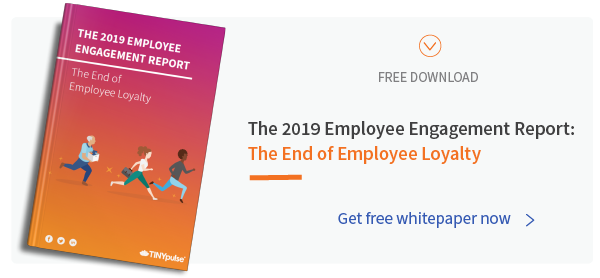How To Design An Employee Experience That Empowers Women
Female leadership and empowerment in the workplace has been on the rise throughout the last several decades, not only paving the way for more female leaders, but also a competitive advantage for many companies.

An MTI study found that mixed gender teams are more productive and creative than those that are not. The research showed that moving to an evenly gender-split office could increase revenue by 41 percent, as “greater social diversity implies a greater spread of experience, which could add to the collective knowledge of a group of office workers and make the unit perform more effectively.”
Gender diversity has also been found to have a positive impact on organizational outcomes such as employee engagement, according to Gallup.
Yet despite this data, there is room for growth at many companies with regards to female leadership, diversity, inclusion, and wage gaps. In fact, at the current rate, the World Economic Forum predicts that it will take 100 years to close the wage gap between men and women.
These are, however, problems that can be corrected by implementing a strategic approach to female empowerment at every level in your organization.
What is the purpose of this guide?
By the time you’re done reading this post, our goal is to have informed and inspired you to implement these strategies at your company, furthering female empowerment and diversity organization-wide.
Who is this guide for?
Whether in executive leadership or entry level, this guide can serve as a starting point about gender equality discussions in your organization. You might think, “These concepts are great, but how can I create change in my role?” These ideas, whether at the individual, team, department, or company-wide, level, start with conversations. We hope that, ultimately, you and your team walk away from reading this post more informed and inspired to take action.
What we’ll cover
We’ll begin by giving a status update of where female employment, leadership, and wages are at today. We’ll take a look back on how this data has changed since 1950, review what barriers still exist for female empowerment and leadership success, as well as a list of steps and examples for implementation at your organization.
The Evolution of Women in the Modern Workplace
Norms around women’s participation in the workplace have changed drastically over the last several decades. In post-WWII America, many women stayed at home rather than working outside of the house, in part due to the large post-war baby boom that occurred from the mid-1940s through the mid-1960s. According to data from the U.S. Bureau of Labor Statistics, the participation rate for women in the workforce in 1950 was just under 35 percent.
Yet as the decades passed, this number has steadily risen. The women’s liberation movement of the late-1960s and 1970s drew public attention to gender-based inequalities. Traditional societal norms - stereotypes of women as caretakers rather than breadwinners - began to change. Women have also increasingly obtained higher education. In fact, data from the U.S. Census Bureau revealed that in many demographics, women have outpaced men in obtaining bachelor’s, master’s, and doctoral degrees.
Ultimately, this has led to an increase of women in the workplace. In 2000, the participation rate for women in the workplace peaked at 60 percent, according to the U.S. Bureau of Labor Statistics. It has had a slight decline since, although holding within 5 percent of this number over the past few years.
This has led to great successes for female employees, business owners, and leaders alike. According to the U.S. Department of Labor, women own close to 10 million businesses, accounting for $1.4 trillion in receipts. The same data set found significant gains with women in professional and managerial roles - in 2016, more than one in three lawyers was a woman compared to fewer than 1 in 10 in 1974. This growth continued into the explosive start-up culture of the last 20 years, as our 2017 Annual Start-Up Culture Report found that female-led start-ups were the fastest-growing.
The Glass Ceiling: Recognizing Barriers to Success
Yet despite these achievements, there is certainly room to grow with regards to female leadership and empowerment in the workplace across many industries. Here’s how.
1. Leadership
Although we’ve seen a dramatic increase of women entering the workforce over the past five decades, women are severely underrepresented in executive leadership. Data from Pew Research Center found that despite a steady increase in the number of female Fortune 500 CEOs over the past decade, this has actually been on the decline since 2017. The number peaked that year at 6.4 percent, yet shrunk to 4.8 percent in 2018. As we wrote about previously here at TINYpulse, this is likely in part due to residual double standards about women in the workplace. Stereotypes still exist that women are unfit for leadership roles, such as being too emotionally-driven. Yet when women are found to contradict these preconceived stereotypes, they are also met with negativity - a woman who is assertive is suddenly perceived as overbearing. In both cases, women are not promoted to leadership roles.
Data obtained in McKinsey and Company’s 2018 Women in the Workplace report found that women are far less likely to be promoted to manager than men, with the ratio of promotions of men versus women at 100-79. This disparity is even larger for women of color, as the ratio of all men to black women is 100-60.
2. Industry
These discrepancies are also industry-specific. Despite the gain in female attorneys mentioned above, women and people of color are still underrepresented in STEM (Science, Technology, Engineering, and Mathematics). The U.S. Department of Labor found that women’s share of computer workers has actually decreased steadily since 1990. This data is echoed for women in the tech/start-up sector, as women make up less than 20 percent of U.S. tech jobs, according to a report by Evia.
What’s more concerning, though, is that this trend seems like it will be slow to change - these disparities not only exist at the professional level, but continue at the college level as well. The number of white men in computer science majors not only vastly exceeds that of women or people of color, but it continues to rise at a faster rate, according to data obtained by the Center for Education Statistics.
3. Payment
The gender wage gap is also still very much alive and well. At the conclusion of Q4 in 2018, the U.S. Bureau of Labor Statistics compared the weekly median salaries of men and women; this amount was $991 for men and $796 for women. This gap is actually $20 larger than it was in 2010.
This discrepancy is not as a result of a lack of asking. According to McKinsey and Company’s 2018 Women in the Workplace report, women ask for promotions and raises just as often as men. Of those surveyed, 29 percent of all men had negotiated a raise in the last two years compared with 31 percent of all women.
4. Family
As Lolly Daskal writes for Inc., women are much more likely than men to have concerns about balancing work and family. This starts with benefits - companies who do not have or prioritize maternity leave put female employees at a disadvantage when balancing work and family. Yet even for workplaces that do have these benefits, many women are hesitant to utilize them to their fullest, as some are shut out of their role if they take their full parental leave.
5. #MeToo
With the emergence of the #MeToo movement in late 2017, a different light was shown on the disparities between men and women in the workplace - one of sex and power. The movement went viral following sexual abuse allegations against Hollywood film producer Harvey Weinstein, and has resulted in many women stepping forward with sexual harassment and assault allegations against powerful men in a variety of industries. McKinsey and Company’s 2018 Women in the Workplace report found that 35 percent of all women surveyed had experienced sexual harassment over the course of their career. This movement serves as a glaring reminder that although women now comprise over half of the U.S. workforce, companies must ensure they have the safeguards necessary to address sexism and harassment in the workplace.
![]()
How to Empower Women in the Workplace
Feeling a bit overwhelmed? These disparities are far-reaching, as their roots exist in society as a whole, not just on your team or at your company. But acknowledging these disparities and strategically implementing policies, trainings, and other resources to address them, are important first steps in changing the narrative around gender equity in the workplace. Here are some ways to get started.
1. Set Diversity Goals and Targets - and Measure Them
The first step towards addressing gender equity is to look closely at your diversity goals and targets - and if you don’t have any, create them. Research by Accenture found that women are twice as likely to be on the fast track to leadership in organizations that have a published diversity target.
By setting policy that addresses diversity at every level of the company, you lay the groundwork for changing biases and promoting inclusive leadership. Work with your Human Resources team to establish how these policies connect with recruiting to ensure your company is doing what it can to bring in diverse talent. For example, as Moz CEO Sarah Bird told us at TINYcon 2018, she does not make hiring decisions unless she has interviewed diverse candidates throughout the entire hiring pipeline.
“It sometimes means I’ll have business roles unfilled three or four times longer than if we just filled it, but I want to live my values,” she said. “There’s a cost to the business, I get pressure, but I’m clinging to my values and integrity.”
The creation of policy, while an important first step, is not enough. Once your company has implemented these policies, it is important to use data collection tools - such as TINYpulse - to measure if these policies are successful. As Vince Vu told us at TINYcon 2018, frequent data pulsing often tells stories that would otherwise go overlooked. By using survey data and focus groups, Vu said he and his team realized there were huge discrepancies about staff opinion of organizational leadership, particularly among women and people of color. By continuously re-visiting this data, you create opportunities for your company’s diversity policies to evolve and improve.
2. Address the Pay Gap
The wage gap, although a nation-wide problem, can be addressed at your company with leadership who are dedicated to reversing this problem.
Sarah Bird also told us at TINYcon 2018 that Moz publicizes salary ranges, or “bands,” for roles. Although employees may not know each other’s exact salary, they understand where they are in relation to their peers. Other companies, such as Whole Foods, have taken this a step further by publishing all employee salaries, regardless of their level in the company.
These policies not only show a commitment to breaking down wage gap barriers, but also emphasize transparency. And what’s more - they create an environment where employees feel as though they can discuss wages more openly with managers.
3. Prioritize Benefits and Work-Life Balance
As your work with your HR team to prioritize diversity policy in the workplace, also consider the benefits your company offers and how you can leverage these to empower women.
Ensure that your company has a substantial maternity leave policy, and work with managers and leadership to ensure that women who take maternity leave do not feel pressure to return to work prematurely over fears that their role will be affected in the long-term. Also work with HR and management to ensure that your company’s hiring process does not discriminate against pregnant women. Hand-in-hand with maternity leave, make sure that your company also prioritizes paternity leave benefits. By doing this, your company equalizes the responsibility of childcare between both parents, rather than it resting heavily on mothers because their partners have to return to work.
Similarly, prioritize a healthy work-life balance for everyone in your company. Although not applicable for every job type, remote work options have become a popular feature in many offices. Flexible Work Arrangements (FWAs), define how, where, and when employees work, allowing them to best manage their career and personal priorities as they see fit. FWAs focus on managing deliverables, not time. Rather than focusing on how much time is spent at a desk, managers are attuned to productivity and results, allowing employees the freedom to manage their own time and priorities. Not only have FWAs become a tool for attracting star talent, but by giving employees ownership and autonomy over their own time, they also contribute to staff retention.
4. Implement Bias Training and Amplification
Preconceived stereotypes and microaggressions relating to gender and race still exist in many workplaces. Data from McKinsey and Company’s 2018 Women in the Workplace report found that 36 percent of all women surveyed had experienced having their judgement questioned in their area of expertise; 31 percent had experienced needing to provide more evidence of competence than others did. This number was even higher for black women at 42 percent.
Address these microaggressions by requiring diversity and inclusive leadership training for all employees, regardless of their level in the company. But completing a required course is just the beginning - build off of these concepts by encouraging discussion around them. These conversations may be uncomfortable for some, but are necessary to correct preconceived biases that may exist around gender and race, and ultimately move forward.
Reversing gender bias cannot occur overnight, and although managerial training helps set a standard, women should be proactive about raising each other up in the workplace, especially when these microaggressions occur. A strategy that has emerged to navigate this is known as amplification. This strategy encourages women to amplify the ideas of other women in situations where they are shut down due to gender bias. For example, if a female coworker’s idea is shot down prematurely, perhaps you take the opportunity to direct the conversation back to that idea for further discussion, crediting that coworker. Although amplification originated as an idea between women, this can be championed by men wanting to raise their female colleagues as well!
5. Mentorship and Professional Growth
Consider the creation of mentorship programs that help amplify female talent in your organization. This could be between executive and entry level employees, for example. Giving star talent the chance to discuss gender equity issues with someone they can relate to can help them navigate these issues in their everyday work, such as facing microaggressions, speaking up about their accomplishments, and advocating for themselves.
This mentorship can also extend beyond the walls of your office. Consider ways that your organization can mentor women and other marginalized populations in your community, especially if you work in an industry where these populations are underrepresented, like tech. Sarah Bird said Moz has partnered with Unloop, an organization that enables incarcerated populations to gain skills and training to begin careers in tech, taking on their first graduate as an intern.
Female empowerment can also create opportunities for networking. Consider inviting strong female leaders in your company or industry to speak on a panel that employees can attend. Encourage these leaders to shed light on topics female employees encounter frequently, such as some of the advice we’ve written about previously here. Also consider hosting a networking event geared towards raising women and people of color. Invite influencers from your industry, current employees, as well as the public to open the door for hiring new talent.
Examples of How Top Companies are Empowering Women
We’ve already highlighted a few female empowerment all-star companies above, but let’s take a closer look at some examples of inclusion strategies at some of the world’s best-known companies.
Wpromote
Digital marketing agency Wpromote created RISE, a women’s initiative that includes community involvement, mentorship, trainings, and other empowerment resources for its employees and community at-large.
Vodafone
British telecom company Vodafone founded the ReConnect project, a paid six-month program across 26 countries aimed at encouraging women who have taken career breaks to return to work by providing professional connections and other resources.
Salesforce
CRM platform Salesforce has invested around $8.7 million to address differences in pay, according to their website. The company also offers 26 weeks of paid parental leave to all employees, regardless of gender.
General Electric
General Electric has had its own employee Women’s Network for over 20 years. The network has donated $1 million to the Society of Women Engineers, funded scholarships to female engineering students, and also organizes STEM camps for girls.
Adobe
In addition to its 26-week maternity leave, software company Adobe created its own Adobe & Women professional network that features female empowerment programming, educational mentorship, and recruiting. The network is led by the company’s Adobe & Women Leadership Council, which includes 25 senior female leaders from the company.
Get Started Today
You’ve got what you need to refine your company’s approach to female empowerment, diversity, and inclusion! Ensure that your leadership are aligned in these approaches as you discuss implementation with your HR team and managers throughout the company. Alignment and clear communication around these initiatives is key for implementation company-wide.
With International Women’s Day approaching on March 8, now is the perfect time to dive into these strategies and policies. Check out our guide to celebrating the movement in your workplace here.
The steps you take to raising female empowerment and inclusion at your company are powerful. They can set the tone for these policies in your industry as a whole, inspire employees to reconsider these biases in their life outside of work, and ultimately contribute to a new chapter in our society’s approach to gender in the workplace.
RELATED POSTS:
- 5 Ways to attract and Retain Strong Female Leaders
- 9 Myths that Hold Female Employees Back, Debunked
- Women Making Waves: Katerina Trajchevska, CEO of Adeva
Share this
You May Also Like
These Related Stories
17 Essential Survey Questions to Predict Employee Attrition and Turnover




.png?width=534&height=632&name=blog%20ad%20(1).png)
